Analysis of Nurse Bullying: A Discussion on Workplace Dynamics
VerifiedAdded on 2022/10/18
|7
|1968
|9
Discussion Board Post
AI Summary
This discussion post examines the pervasive issue of nurse bullying in healthcare settings, exploring its causes, consequences, and potential solutions. The assignment centers on a case study involving a pediatric nurse, T.M., who experienced bullying, incivility, and clique behavior in a Labor & Delivery unit. The analysis delves into the impact of such behaviors on nurses' well-being, patient safety, and organizational effectiveness. The post discusses the definition of bullying, its impact on nurses, and the importance of interventions. The post also analyzes T.M.'s experiences, the responses of supervisors, and alternative actions T.M. could have taken. The assignment concludes with the importance of leaders setting zero-tolerance standards and providing training to address the issue, thereby improving nurse staffing, efficiency, and patient safety. The post references relevant literature and explores ways to create a supportive and ethical work environment.
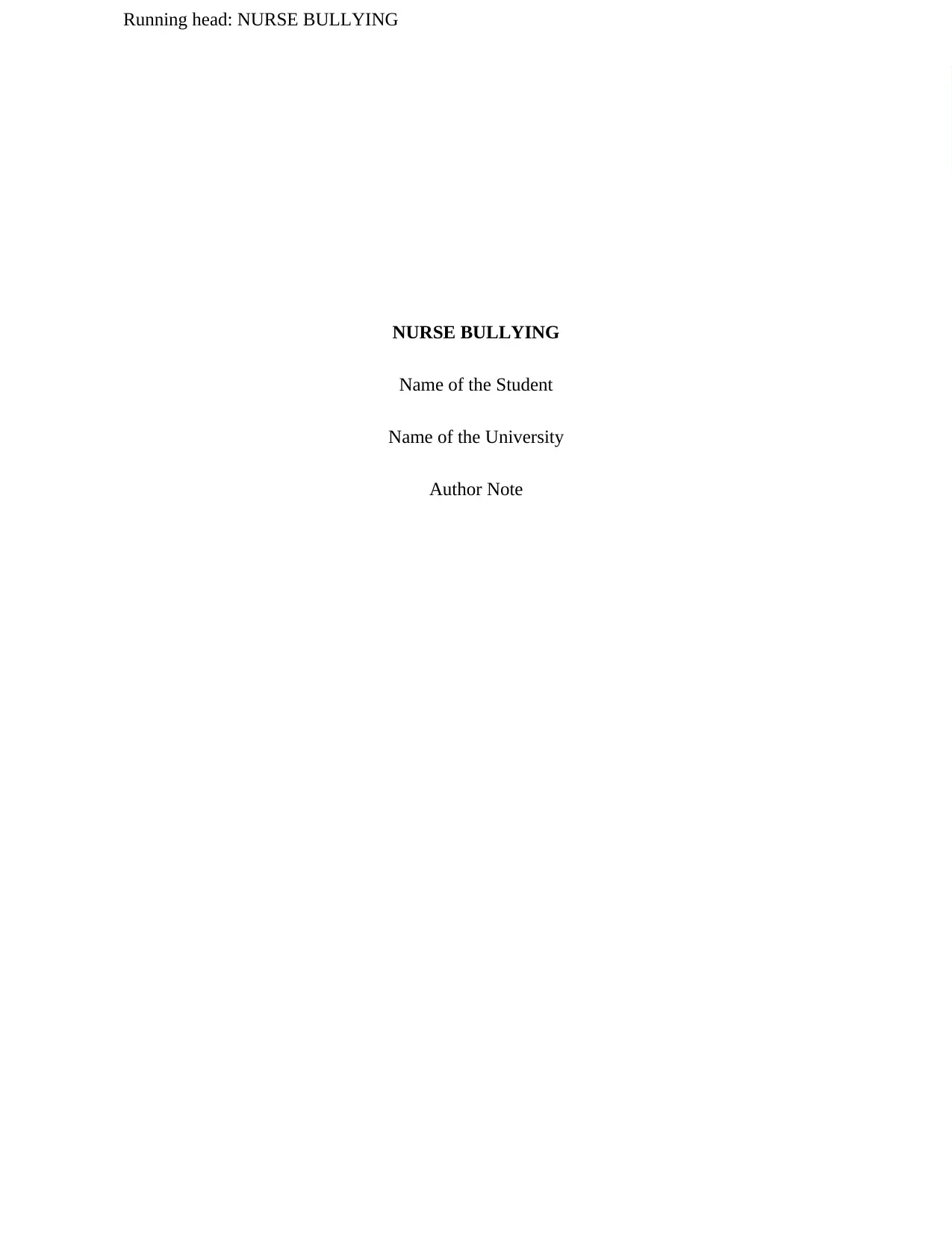
Running head: NURSE BULLYING
NURSE BULLYING
Name of the Student
Name of the University
Author Note
NURSE BULLYING
Name of the Student
Name of the University
Author Note
Paraphrase This Document
Need a fresh take? Get an instant paraphrase of this document with our AI Paraphraser
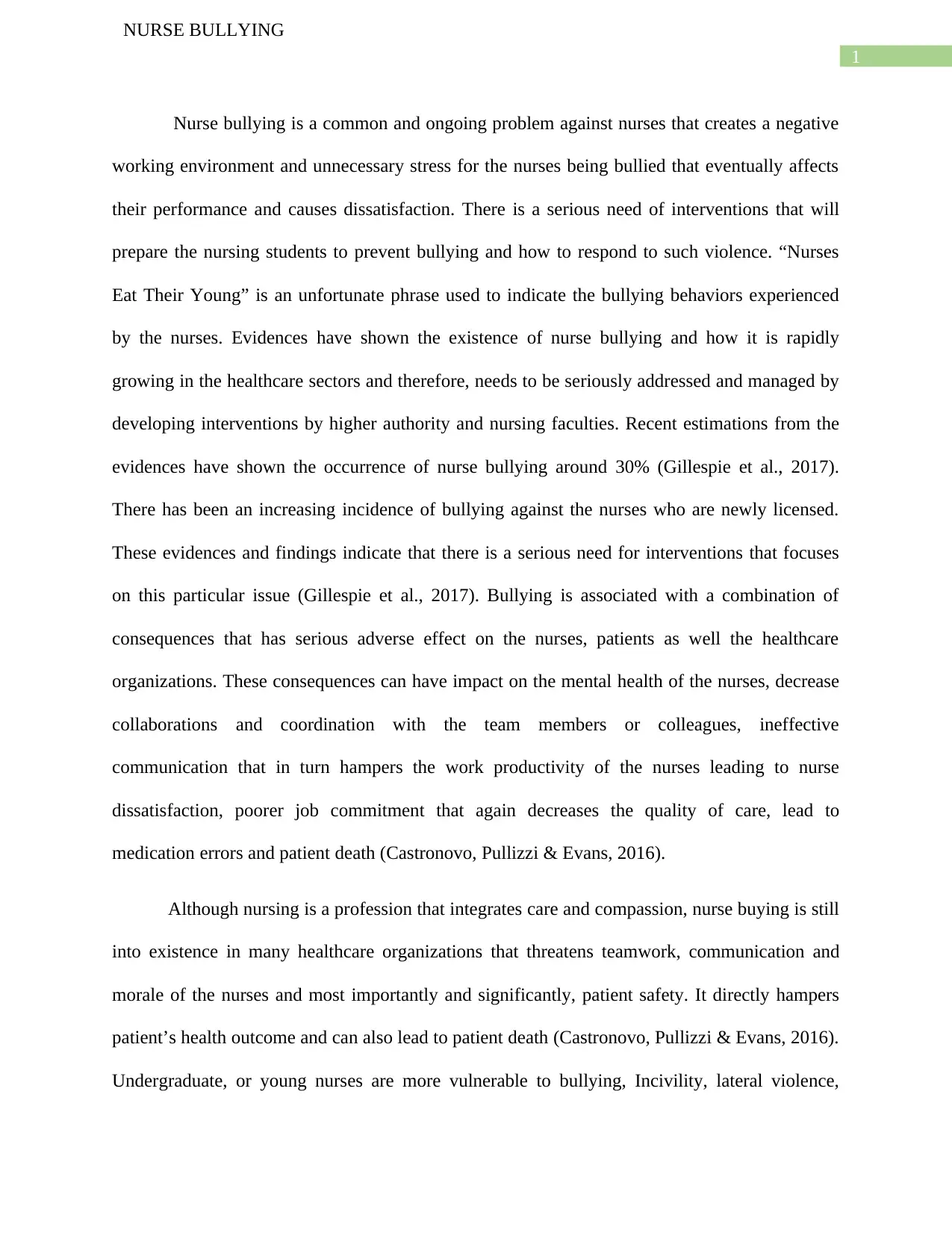
1
NURSE BULLYING
Nurse bullying is a common and ongoing problem against nurses that creates a negative
working environment and unnecessary stress for the nurses being bullied that eventually affects
their performance and causes dissatisfaction. There is a serious need of interventions that will
prepare the nursing students to prevent bullying and how to respond to such violence. “Nurses
Eat Their Young” is an unfortunate phrase used to indicate the bullying behaviors experienced
by the nurses. Evidences have shown the existence of nurse bullying and how it is rapidly
growing in the healthcare sectors and therefore, needs to be seriously addressed and managed by
developing interventions by higher authority and nursing faculties. Recent estimations from the
evidences have shown the occurrence of nurse bullying around 30% (Gillespie et al., 2017).
There has been an increasing incidence of bullying against the nurses who are newly licensed.
These evidences and findings indicate that there is a serious need for interventions that focuses
on this particular issue (Gillespie et al., 2017). Bullying is associated with a combination of
consequences that has serious adverse effect on the nurses, patients as well the healthcare
organizations. These consequences can have impact on the mental health of the nurses, decrease
collaborations and coordination with the team members or colleagues, ineffective
communication that in turn hampers the work productivity of the nurses leading to nurse
dissatisfaction, poorer job commitment that again decreases the quality of care, lead to
medication errors and patient death (Castronovo, Pullizzi & Evans, 2016).
Although nursing is a profession that integrates care and compassion, nurse buying is still
into existence in many healthcare organizations that threatens teamwork, communication and
morale of the nurses and most importantly and significantly, patient safety. It directly hampers
patient’s health outcome and can also lead to patient death (Castronovo, Pullizzi & Evans, 2016).
Undergraduate, or young nurses are more vulnerable to bullying, Incivility, lateral violence,
NURSE BULLYING
Nurse bullying is a common and ongoing problem against nurses that creates a negative
working environment and unnecessary stress for the nurses being bullied that eventually affects
their performance and causes dissatisfaction. There is a serious need of interventions that will
prepare the nursing students to prevent bullying and how to respond to such violence. “Nurses
Eat Their Young” is an unfortunate phrase used to indicate the bullying behaviors experienced
by the nurses. Evidences have shown the existence of nurse bullying and how it is rapidly
growing in the healthcare sectors and therefore, needs to be seriously addressed and managed by
developing interventions by higher authority and nursing faculties. Recent estimations from the
evidences have shown the occurrence of nurse bullying around 30% (Gillespie et al., 2017).
There has been an increasing incidence of bullying against the nurses who are newly licensed.
These evidences and findings indicate that there is a serious need for interventions that focuses
on this particular issue (Gillespie et al., 2017). Bullying is associated with a combination of
consequences that has serious adverse effect on the nurses, patients as well the healthcare
organizations. These consequences can have impact on the mental health of the nurses, decrease
collaborations and coordination with the team members or colleagues, ineffective
communication that in turn hampers the work productivity of the nurses leading to nurse
dissatisfaction, poorer job commitment that again decreases the quality of care, lead to
medication errors and patient death (Castronovo, Pullizzi & Evans, 2016).
Although nursing is a profession that integrates care and compassion, nurse buying is still
into existence in many healthcare organizations that threatens teamwork, communication and
morale of the nurses and most importantly and significantly, patient safety. It directly hampers
patient’s health outcome and can also lead to patient death (Castronovo, Pullizzi & Evans, 2016).
Undergraduate, or young nurses are more vulnerable to bullying, Incivility, lateral violence,
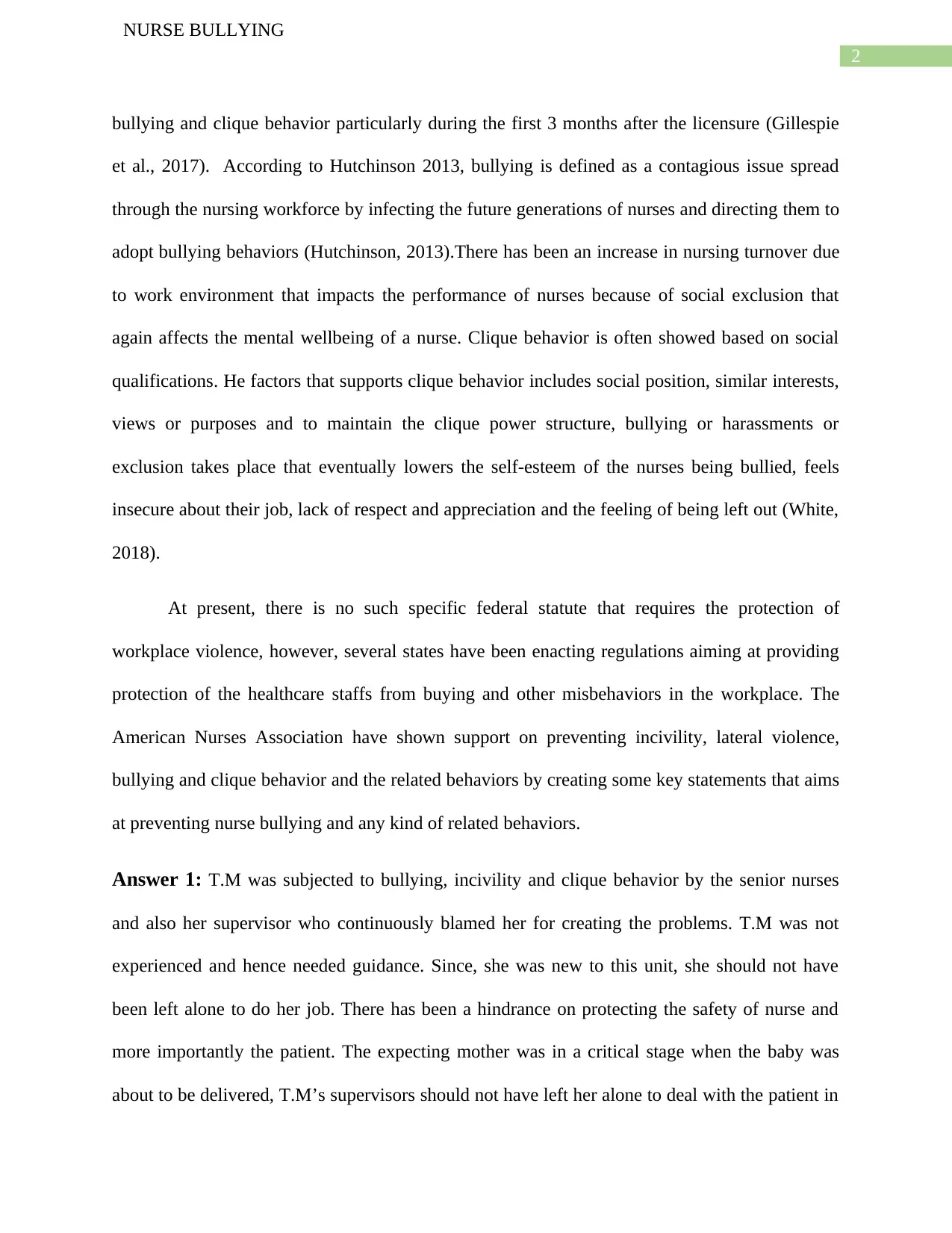
2
NURSE BULLYING
bullying and clique behavior particularly during the first 3 months after the licensure (Gillespie
et al., 2017). According to Hutchinson 2013, bullying is defined as a contagious issue spread
through the nursing workforce by infecting the future generations of nurses and directing them to
adopt bullying behaviors (Hutchinson, 2013).There has been an increase in nursing turnover due
to work environment that impacts the performance of nurses because of social exclusion that
again affects the mental wellbeing of a nurse. Clique behavior is often showed based on social
qualifications. He factors that supports clique behavior includes social position, similar interests,
views or purposes and to maintain the clique power structure, bullying or harassments or
exclusion takes place that eventually lowers the self-esteem of the nurses being bullied, feels
insecure about their job, lack of respect and appreciation and the feeling of being left out (White,
2018).
At present, there is no such specific federal statute that requires the protection of
workplace violence, however, several states have been enacting regulations aiming at providing
protection of the healthcare staffs from buying and other misbehaviors in the workplace. The
American Nurses Association have shown support on preventing incivility, lateral violence,
bullying and clique behavior and the related behaviors by creating some key statements that aims
at preventing nurse bullying and any kind of related behaviors.
Answer 1: T.M was subjected to bullying, incivility and clique behavior by the senior nurses
and also her supervisor who continuously blamed her for creating the problems. T.M was not
experienced and hence needed guidance. Since, she was new to this unit, she should not have
been left alone to do her job. There has been a hindrance on protecting the safety of nurse and
more importantly the patient. The expecting mother was in a critical stage when the baby was
about to be delivered, T.M’s supervisors should not have left her alone to deal with the patient in
NURSE BULLYING
bullying and clique behavior particularly during the first 3 months after the licensure (Gillespie
et al., 2017). According to Hutchinson 2013, bullying is defined as a contagious issue spread
through the nursing workforce by infecting the future generations of nurses and directing them to
adopt bullying behaviors (Hutchinson, 2013).There has been an increase in nursing turnover due
to work environment that impacts the performance of nurses because of social exclusion that
again affects the mental wellbeing of a nurse. Clique behavior is often showed based on social
qualifications. He factors that supports clique behavior includes social position, similar interests,
views or purposes and to maintain the clique power structure, bullying or harassments or
exclusion takes place that eventually lowers the self-esteem of the nurses being bullied, feels
insecure about their job, lack of respect and appreciation and the feeling of being left out (White,
2018).
At present, there is no such specific federal statute that requires the protection of
workplace violence, however, several states have been enacting regulations aiming at providing
protection of the healthcare staffs from buying and other misbehaviors in the workplace. The
American Nurses Association have shown support on preventing incivility, lateral violence,
bullying and clique behavior and the related behaviors by creating some key statements that aims
at preventing nurse bullying and any kind of related behaviors.
Answer 1: T.M was subjected to bullying, incivility and clique behavior by the senior nurses
and also her supervisor who continuously blamed her for creating the problems. T.M was not
experienced and hence needed guidance. Since, she was new to this unit, she should not have
been left alone to do her job. There has been a hindrance on protecting the safety of nurse and
more importantly the patient. The expecting mother was in a critical stage when the baby was
about to be delivered, T.M’s supervisors should not have left her alone to deal with the patient in
⊘ This is a preview!⊘
Do you want full access?
Subscribe today to unlock all pages.

Trusted by 1+ million students worldwide
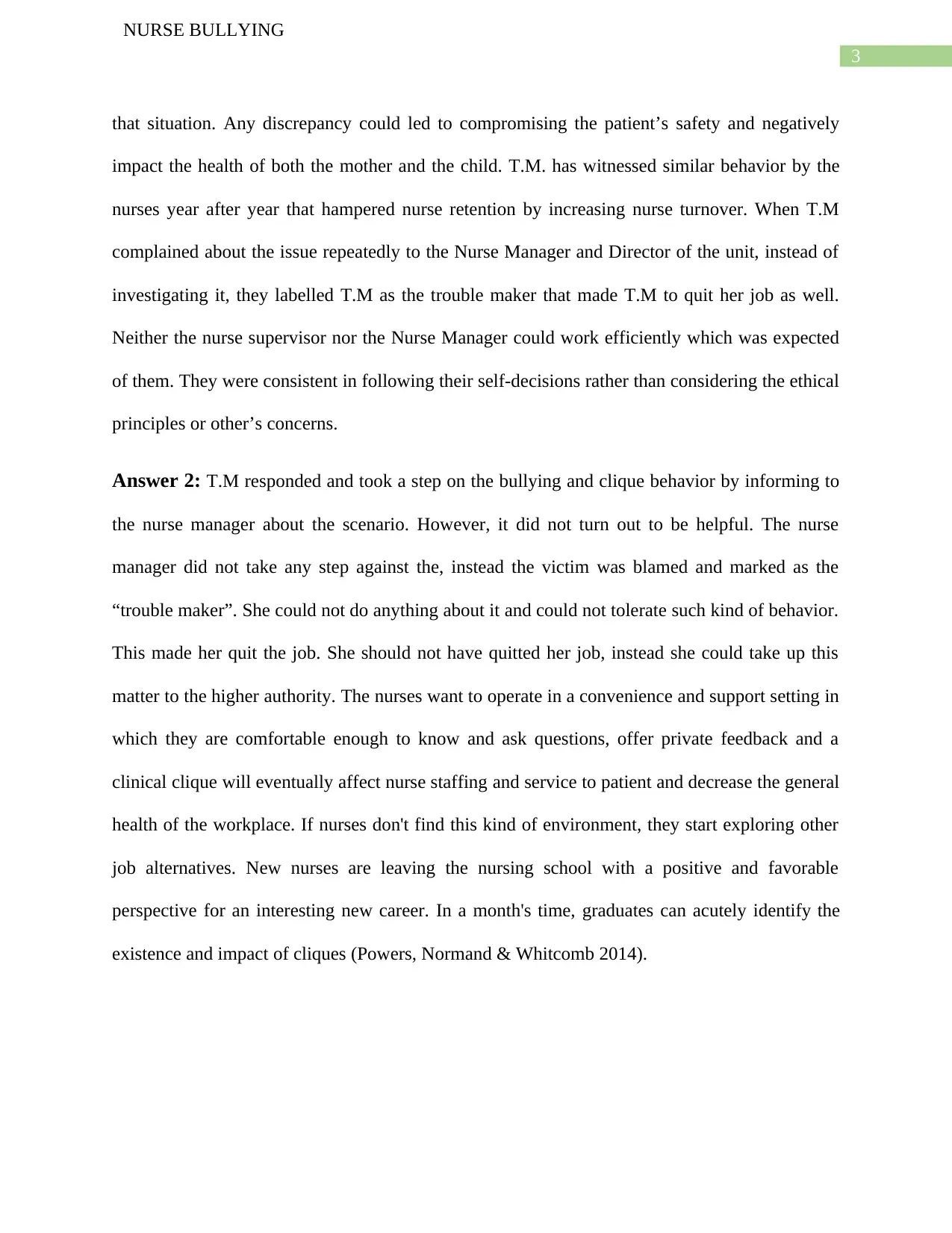
3
NURSE BULLYING
that situation. Any discrepancy could led to compromising the patient’s safety and negatively
impact the health of both the mother and the child. T.M. has witnessed similar behavior by the
nurses year after year that hampered nurse retention by increasing nurse turnover. When T.M
complained about the issue repeatedly to the Nurse Manager and Director of the unit, instead of
investigating it, they labelled T.M as the trouble maker that made T.M to quit her job as well.
Neither the nurse supervisor nor the Nurse Manager could work efficiently which was expected
of them. They were consistent in following their self-decisions rather than considering the ethical
principles or other’s concerns.
Answer 2: T.M responded and took a step on the bullying and clique behavior by informing to
the nurse manager about the scenario. However, it did not turn out to be helpful. The nurse
manager did not take any step against the, instead the victim was blamed and marked as the
“trouble maker”. She could not do anything about it and could not tolerate such kind of behavior.
This made her quit the job. She should not have quitted her job, instead she could take up this
matter to the higher authority. The nurses want to operate in a convenience and support setting in
which they are comfortable enough to know and ask questions, offer private feedback and a
clinical clique will eventually affect nurse staffing and service to patient and decrease the general
health of the workplace. If nurses don't find this kind of environment, they start exploring other
job alternatives. New nurses are leaving the nursing school with a positive and favorable
perspective for an interesting new career. In a month's time, graduates can acutely identify the
existence and impact of cliques (Powers, Normand & Whitcomb 2014).
NURSE BULLYING
that situation. Any discrepancy could led to compromising the patient’s safety and negatively
impact the health of both the mother and the child. T.M. has witnessed similar behavior by the
nurses year after year that hampered nurse retention by increasing nurse turnover. When T.M
complained about the issue repeatedly to the Nurse Manager and Director of the unit, instead of
investigating it, they labelled T.M as the trouble maker that made T.M to quit her job as well.
Neither the nurse supervisor nor the Nurse Manager could work efficiently which was expected
of them. They were consistent in following their self-decisions rather than considering the ethical
principles or other’s concerns.
Answer 2: T.M responded and took a step on the bullying and clique behavior by informing to
the nurse manager about the scenario. However, it did not turn out to be helpful. The nurse
manager did not take any step against the, instead the victim was blamed and marked as the
“trouble maker”. She could not do anything about it and could not tolerate such kind of behavior.
This made her quit the job. She should not have quitted her job, instead she could take up this
matter to the higher authority. The nurses want to operate in a convenience and support setting in
which they are comfortable enough to know and ask questions, offer private feedback and a
clinical clique will eventually affect nurse staffing and service to patient and decrease the general
health of the workplace. If nurses don't find this kind of environment, they start exploring other
job alternatives. New nurses are leaving the nursing school with a positive and favorable
perspective for an interesting new career. In a month's time, graduates can acutely identify the
existence and impact of cliques (Powers, Normand & Whitcomb 2014).
Paraphrase This Document
Need a fresh take? Get an instant paraphrase of this document with our AI Paraphraser
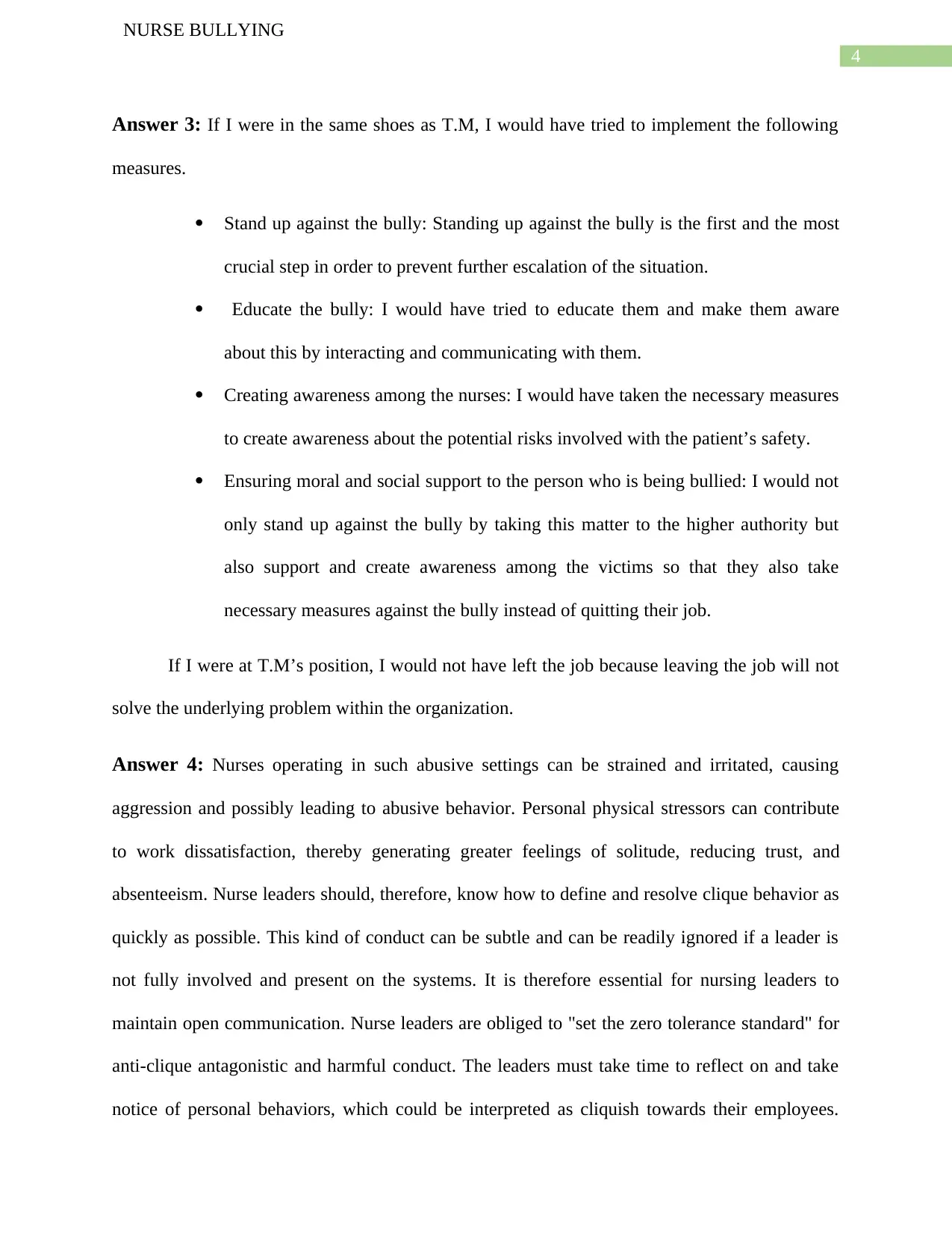
4
NURSE BULLYING
Answer 3: If I were in the same shoes as T.M, I would have tried to implement the following
measures.
Stand up against the bully: Standing up against the bully is the first and the most
crucial step in order to prevent further escalation of the situation.
Educate the bully: I would have tried to educate them and make them aware
about this by interacting and communicating with them.
Creating awareness among the nurses: I would have taken the necessary measures
to create awareness about the potential risks involved with the patient’s safety.
Ensuring moral and social support to the person who is being bullied: I would not
only stand up against the bully by taking this matter to the higher authority but
also support and create awareness among the victims so that they also take
necessary measures against the bully instead of quitting their job.
If I were at T.M’s position, I would not have left the job because leaving the job will not
solve the underlying problem within the organization.
Answer 4: Nurses operating in such abusive settings can be strained and irritated, causing
aggression and possibly leading to abusive behavior. Personal physical stressors can contribute
to work dissatisfaction, thereby generating greater feelings of solitude, reducing trust, and
absenteeism. Nurse leaders should, therefore, know how to define and resolve clique behavior as
quickly as possible. This kind of conduct can be subtle and can be readily ignored if a leader is
not fully involved and present on the systems. It is therefore essential for nursing leaders to
maintain open communication. Nurse leaders are obliged to "set the zero tolerance standard" for
anti-clique antagonistic and harmful conduct. The leaders must take time to reflect on and take
notice of personal behaviors, which could be interpreted as cliquish towards their employees.
NURSE BULLYING
Answer 3: If I were in the same shoes as T.M, I would have tried to implement the following
measures.
Stand up against the bully: Standing up against the bully is the first and the most
crucial step in order to prevent further escalation of the situation.
Educate the bully: I would have tried to educate them and make them aware
about this by interacting and communicating with them.
Creating awareness among the nurses: I would have taken the necessary measures
to create awareness about the potential risks involved with the patient’s safety.
Ensuring moral and social support to the person who is being bullied: I would not
only stand up against the bully by taking this matter to the higher authority but
also support and create awareness among the victims so that they also take
necessary measures against the bully instead of quitting their job.
If I were at T.M’s position, I would not have left the job because leaving the job will not
solve the underlying problem within the organization.
Answer 4: Nurses operating in such abusive settings can be strained and irritated, causing
aggression and possibly leading to abusive behavior. Personal physical stressors can contribute
to work dissatisfaction, thereby generating greater feelings of solitude, reducing trust, and
absenteeism. Nurse leaders should, therefore, know how to define and resolve clique behavior as
quickly as possible. This kind of conduct can be subtle and can be readily ignored if a leader is
not fully involved and present on the systems. It is therefore essential for nursing leaders to
maintain open communication. Nurse leaders are obliged to "set the zero tolerance standard" for
anti-clique antagonistic and harmful conduct. The leaders must take time to reflect on and take
notice of personal behaviors, which could be interpreted as cliquish towards their employees.
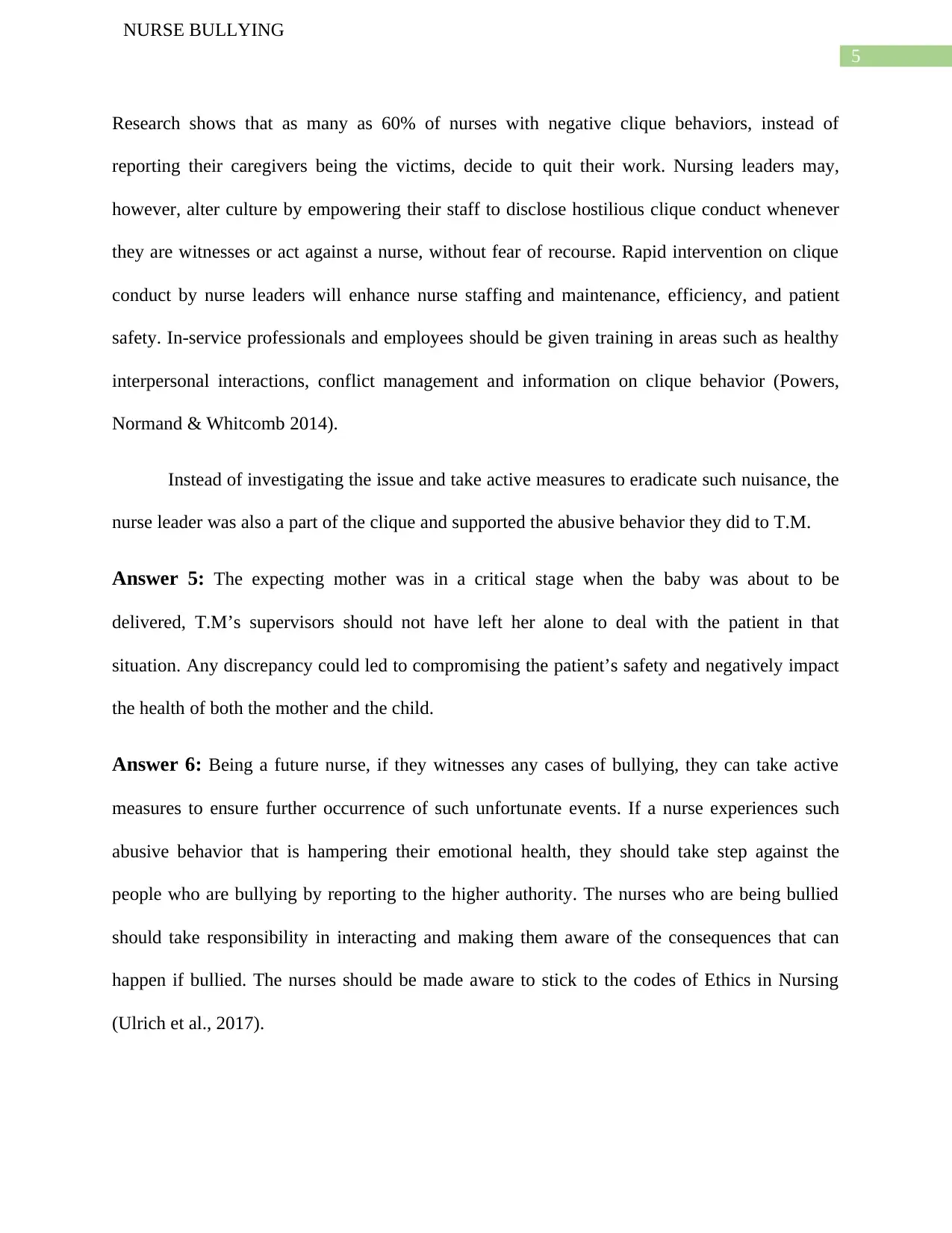
5
NURSE BULLYING
Research shows that as many as 60% of nurses with negative clique behaviors, instead of
reporting their caregivers being the victims, decide to quit their work. Nursing leaders may,
however, alter culture by empowering their staff to disclose hostilious clique conduct whenever
they are witnesses or act against a nurse, without fear of recourse. Rapid intervention on clique
conduct by nurse leaders will enhance nurse staffing and maintenance, efficiency, and patient
safety. In-service professionals and employees should be given training in areas such as healthy
interpersonal interactions, conflict management and information on clique behavior (Powers,
Normand & Whitcomb 2014).
Instead of investigating the issue and take active measures to eradicate such nuisance, the
nurse leader was also a part of the clique and supported the abusive behavior they did to T.M.
Answer 5: The expecting mother was in a critical stage when the baby was about to be
delivered, T.M’s supervisors should not have left her alone to deal with the patient in that
situation. Any discrepancy could led to compromising the patient’s safety and negatively impact
the health of both the mother and the child.
Answer 6: Being a future nurse, if they witnesses any cases of bullying, they can take active
measures to ensure further occurrence of such unfortunate events. If a nurse experiences such
abusive behavior that is hampering their emotional health, they should take step against the
people who are bullying by reporting to the higher authority. The nurses who are being bullied
should take responsibility in interacting and making them aware of the consequences that can
happen if bullied. The nurses should be made aware to stick to the codes of Ethics in Nursing
(Ulrich et al., 2017).
NURSE BULLYING
Research shows that as many as 60% of nurses with negative clique behaviors, instead of
reporting their caregivers being the victims, decide to quit their work. Nursing leaders may,
however, alter culture by empowering their staff to disclose hostilious clique conduct whenever
they are witnesses or act against a nurse, without fear of recourse. Rapid intervention on clique
conduct by nurse leaders will enhance nurse staffing and maintenance, efficiency, and patient
safety. In-service professionals and employees should be given training in areas such as healthy
interpersonal interactions, conflict management and information on clique behavior (Powers,
Normand & Whitcomb 2014).
Instead of investigating the issue and take active measures to eradicate such nuisance, the
nurse leader was also a part of the clique and supported the abusive behavior they did to T.M.
Answer 5: The expecting mother was in a critical stage when the baby was about to be
delivered, T.M’s supervisors should not have left her alone to deal with the patient in that
situation. Any discrepancy could led to compromising the patient’s safety and negatively impact
the health of both the mother and the child.
Answer 6: Being a future nurse, if they witnesses any cases of bullying, they can take active
measures to ensure further occurrence of such unfortunate events. If a nurse experiences such
abusive behavior that is hampering their emotional health, they should take step against the
people who are bullying by reporting to the higher authority. The nurses who are being bullied
should take responsibility in interacting and making them aware of the consequences that can
happen if bullied. The nurses should be made aware to stick to the codes of Ethics in Nursing
(Ulrich et al., 2017).
⊘ This is a preview!⊘
Do you want full access?
Subscribe today to unlock all pages.

Trusted by 1+ million students worldwide
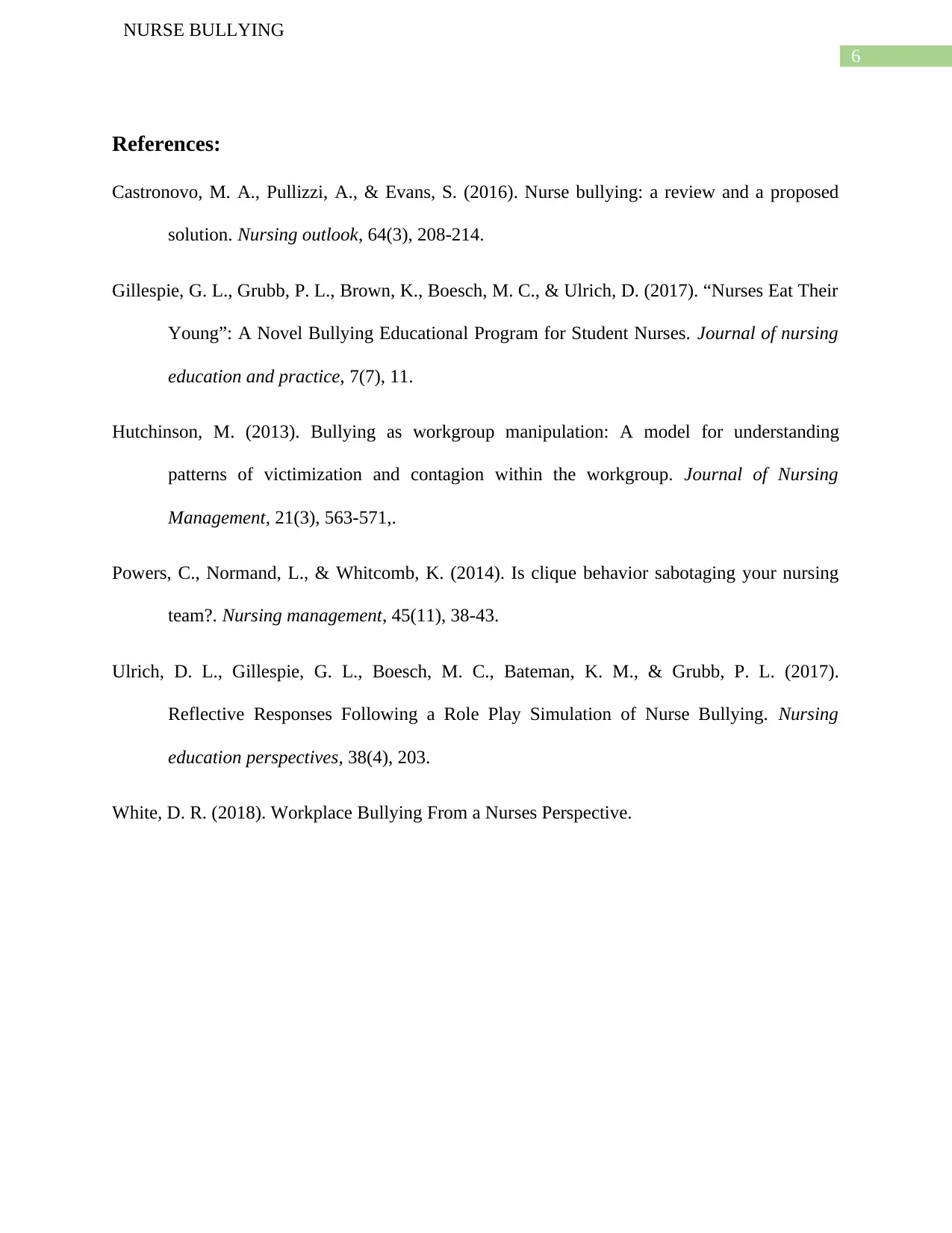
6
NURSE BULLYING
References:
Castronovo, M. A., Pullizzi, A., & Evans, S. (2016). Nurse bullying: a review and a proposed
solution. Nursing outlook, 64(3), 208-214.
Gillespie, G. L., Grubb, P. L., Brown, K., Boesch, M. C., & Ulrich, D. (2017). “Nurses Eat Their
Young”: A Novel Bullying Educational Program for Student Nurses. Journal of nursing
education and practice, 7(7), 11.
Hutchinson, M. (2013). Bullying as workgroup manipulation: A model for understanding
patterns of victimization and contagion within the workgroup. Journal of Nursing
Management, 21(3), 563-571,.
Powers, C., Normand, L., & Whitcomb, K. (2014). Is clique behavior sabotaging your nursing
team?. Nursing management, 45(11), 38-43.
Ulrich, D. L., Gillespie, G. L., Boesch, M. C., Bateman, K. M., & Grubb, P. L. (2017).
Reflective Responses Following a Role Play Simulation of Nurse Bullying. Nursing
education perspectives, 38(4), 203.
White, D. R. (2018). Workplace Bullying From a Nurses Perspective.
NURSE BULLYING
References:
Castronovo, M. A., Pullizzi, A., & Evans, S. (2016). Nurse bullying: a review and a proposed
solution. Nursing outlook, 64(3), 208-214.
Gillespie, G. L., Grubb, P. L., Brown, K., Boesch, M. C., & Ulrich, D. (2017). “Nurses Eat Their
Young”: A Novel Bullying Educational Program for Student Nurses. Journal of nursing
education and practice, 7(7), 11.
Hutchinson, M. (2013). Bullying as workgroup manipulation: A model for understanding
patterns of victimization and contagion within the workgroup. Journal of Nursing
Management, 21(3), 563-571,.
Powers, C., Normand, L., & Whitcomb, K. (2014). Is clique behavior sabotaging your nursing
team?. Nursing management, 45(11), 38-43.
Ulrich, D. L., Gillespie, G. L., Boesch, M. C., Bateman, K. M., & Grubb, P. L. (2017).
Reflective Responses Following a Role Play Simulation of Nurse Bullying. Nursing
education perspectives, 38(4), 203.
White, D. R. (2018). Workplace Bullying From a Nurses Perspective.
1 out of 7
Your All-in-One AI-Powered Toolkit for Academic Success.
+13062052269
info@desklib.com
Available 24*7 on WhatsApp / Email
![[object Object]](/_next/static/media/star-bottom.7253800d.svg)
Unlock your academic potential
Copyright © 2020–2025 A2Z Services. All Rights Reserved. Developed and managed by ZUCOL.
